Basketball drills
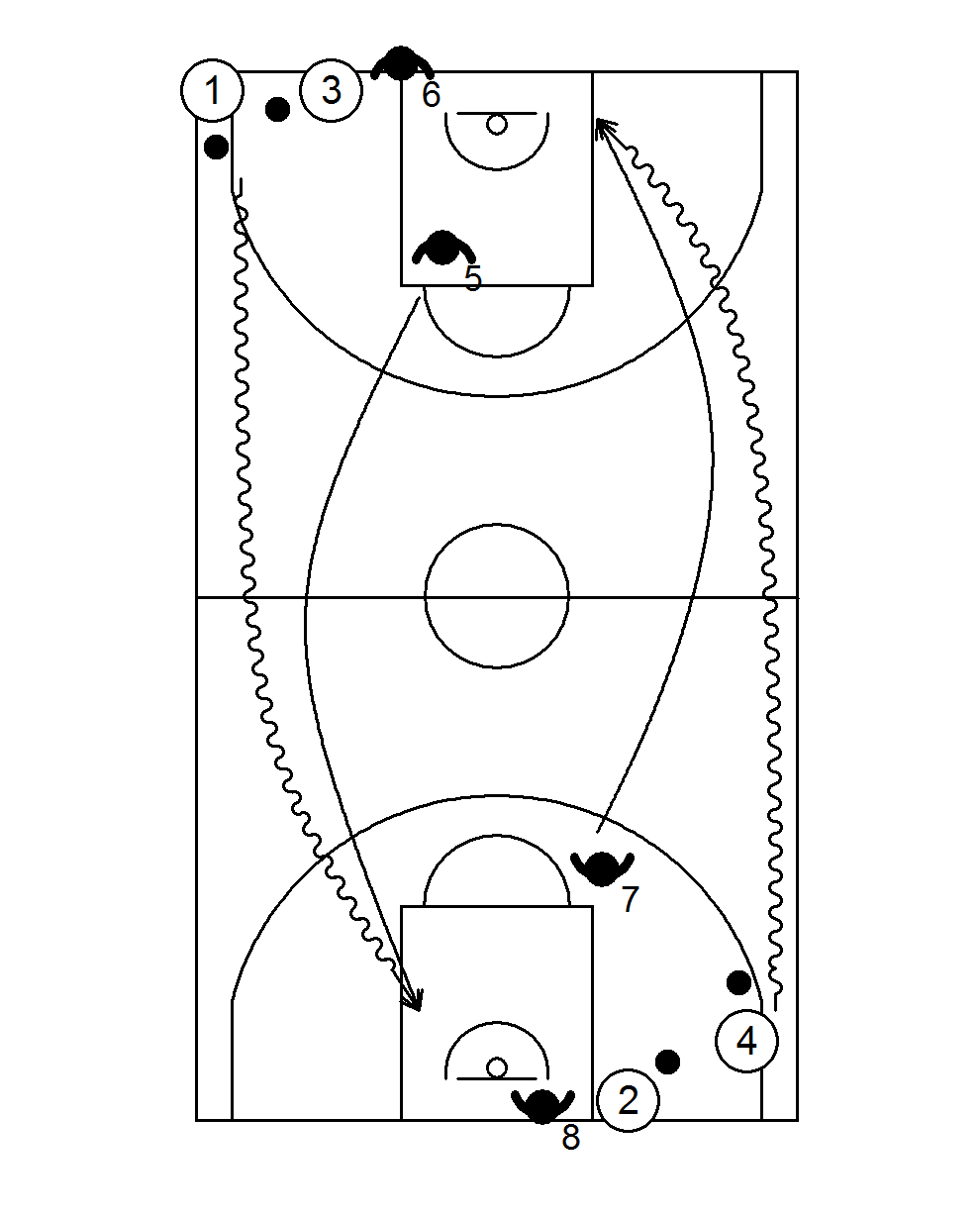
Requirements:
- players must be able to individually defend the man with the ball
- players must be able to dribble
Goal: defender must force the dribbler to the side of the field. Dribbler must never penetrate over the defender's front foot and through the middle
Organization:
- 1 against 1 across the longitudinal half
- Loser must defend in the next round
- defender must press down 3 times if the attacker comes between the defender and the helpline anyway
Teaching Points:
- defender must keep an appropriate distance, taking into account the dexterity and speed of the dribbler
- defender must keep a constant distance from the three-point line (i.e. when the attacker comes within shooting distance of the basket)
- as the skill of the defenders increases, reduce the distance to the attackers
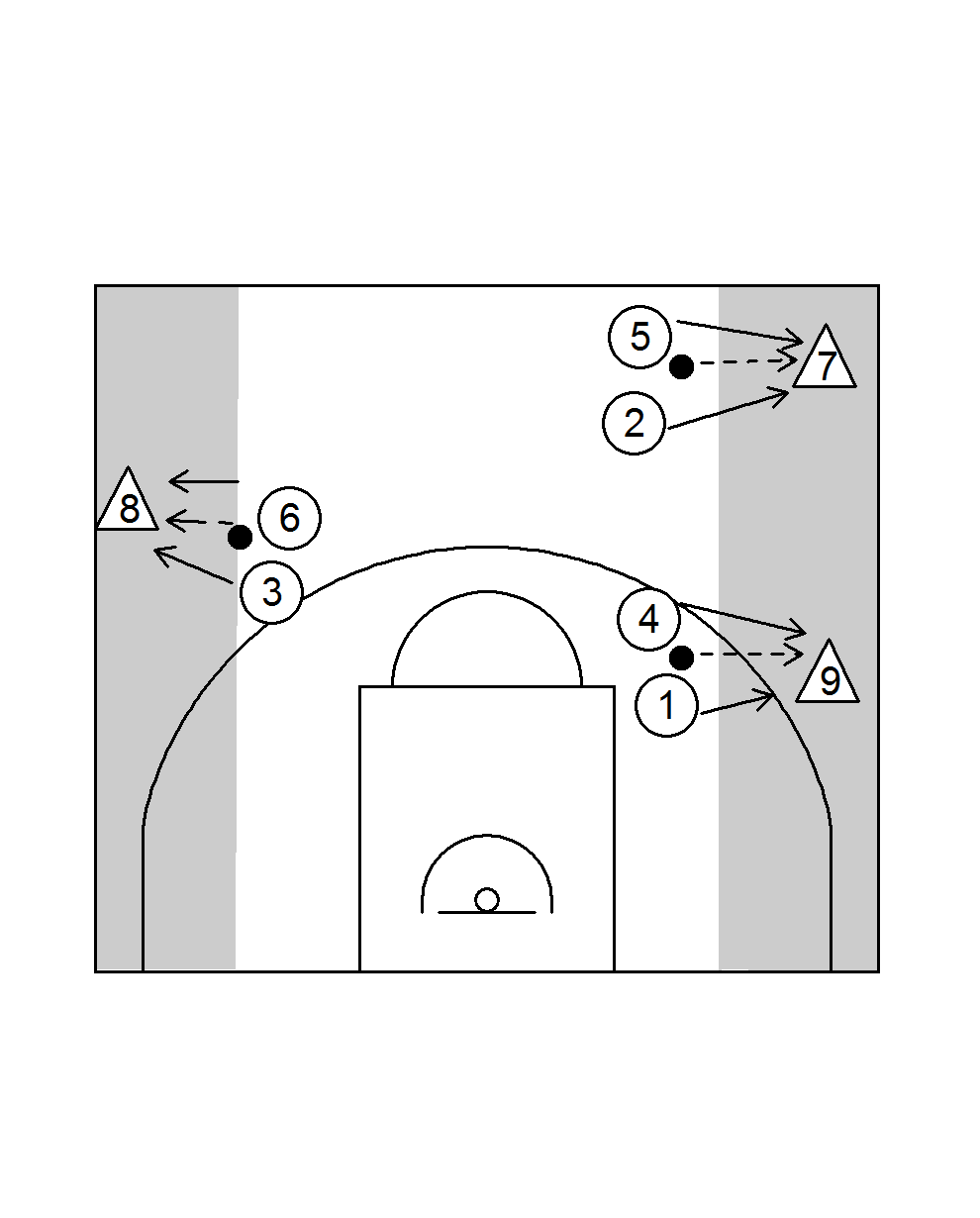
Goal: securing the dribbler against the sideline after stopping the dribble
Organisation:
- defender passes to attacker on signal of the coach
- Attacker is NOT allowed to dribble, only to pivot.
- the trainer counts down 5 seconds
Teaching Points:
- Get as close to the attacker as possible (but stay in your own cylinder).
- Move your feet closer to the attacker, but keep your position between the attacker and the helpline.
- If the attacker allows you to have his back, move your feet forward.
- trace the ball
- defenders always one hand low and one hand high (Umbrella)
- the attacker is never allowed to step or pass between the defenders (only passes parallel to the sideline are allowed)
- avoid mistakes; conquer ball by 1) 5 seconds, 2) bad pass, 3) attacker's foot on the line
Form of play:
Two additional attackers running free outside the lane. A successful pass between the defenders is a point for the attackers. 5 seconds or foot of the attacker on the line is a point for the defenders. Play to the 2.

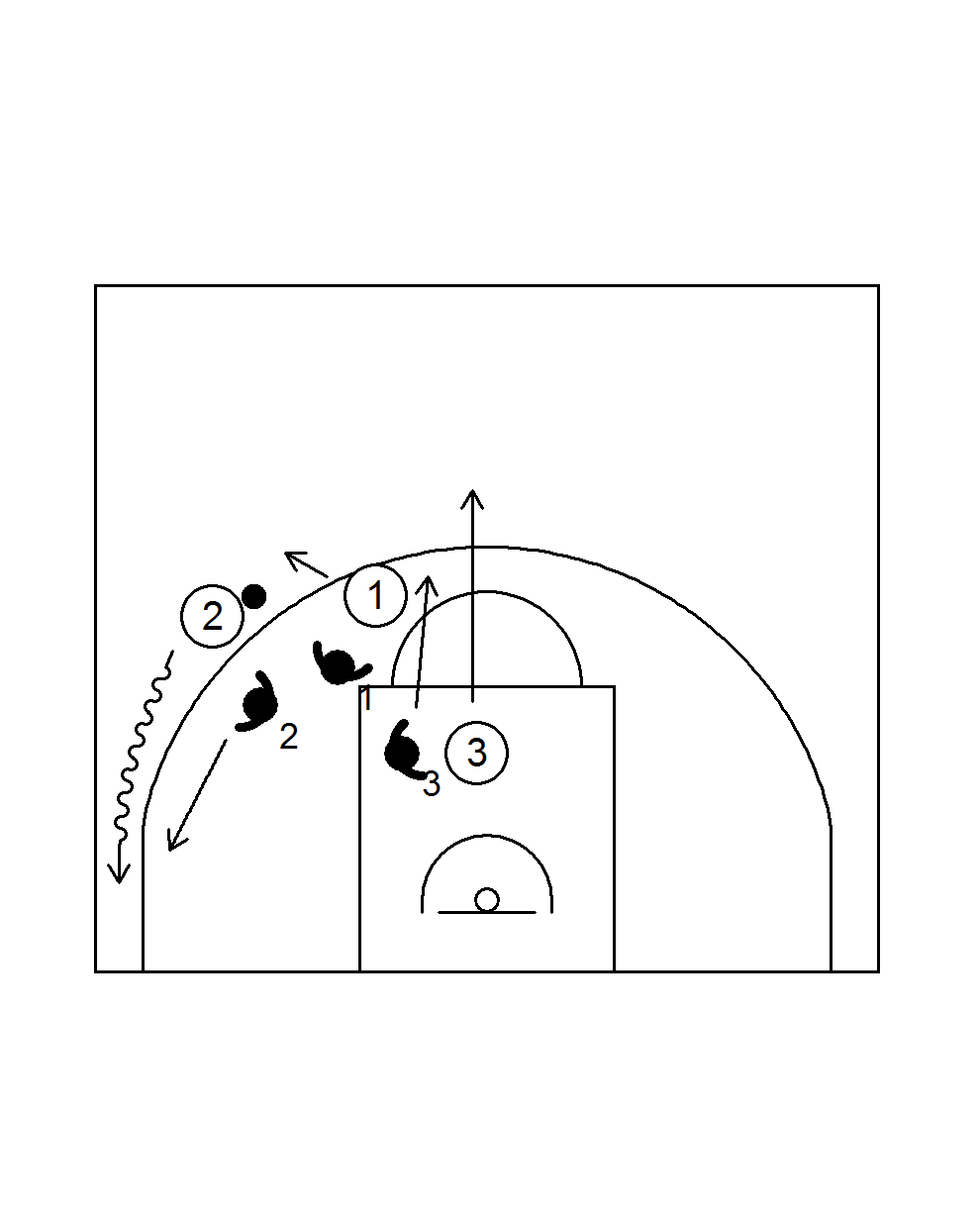
Goal: to defend one pass away
Organization:
- attackers use quarter of the field
- try to get free with in-out or cut
- first restore balance by occupying the 3 positions before cutting again
- defender overplays when his man is playable with one pass
- attacker can dribble
- a waiting player counts down 20 seconds
Teaching Points:
- hand in the passing line
- front foot in the passing line
- catch your man with your forearm
- 3/4 of your attention on the man, 1/4 on the ball
- NO help
- change after x stops
Form of play:
- each team gets 5x ball possession
- who makes the most stops
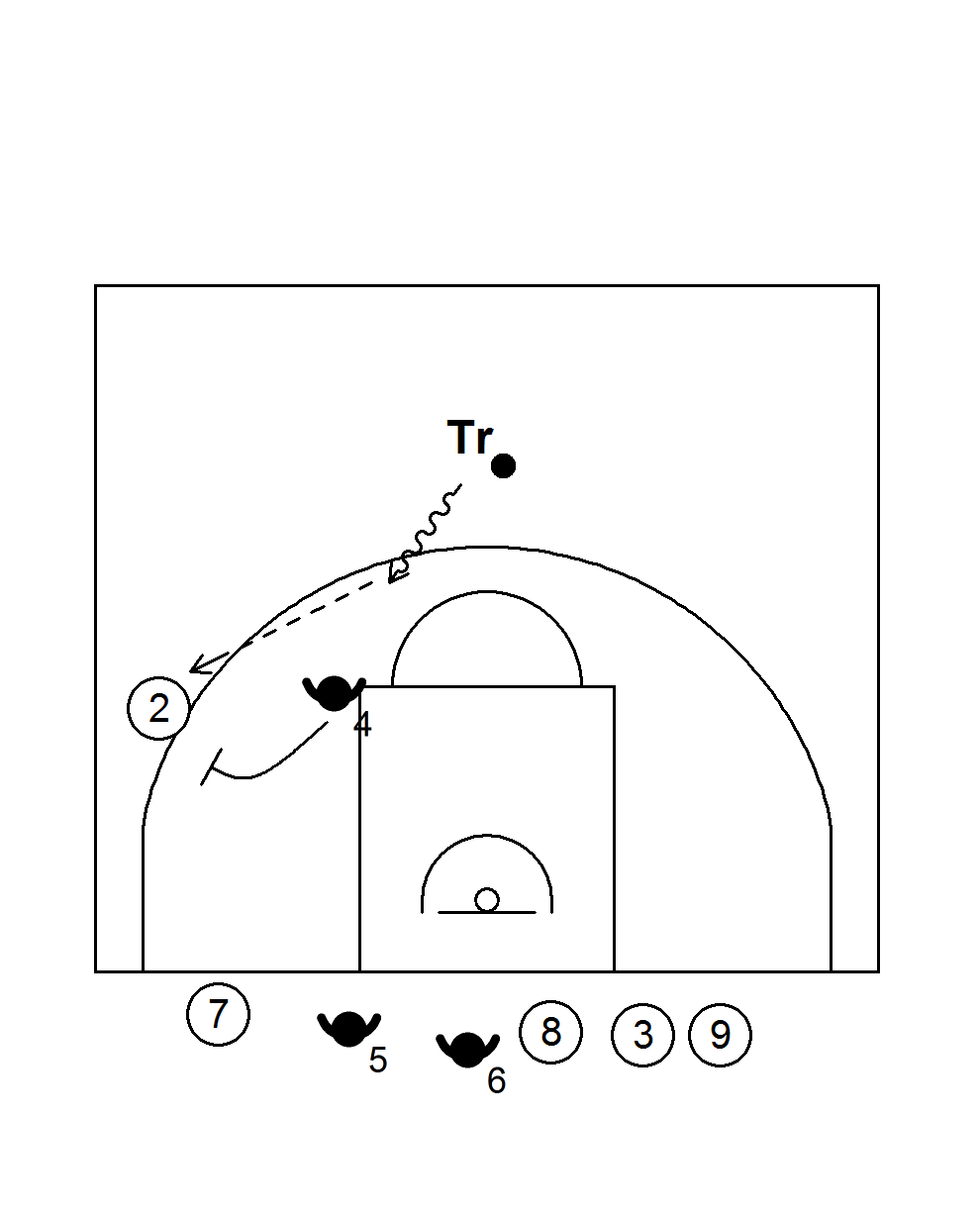
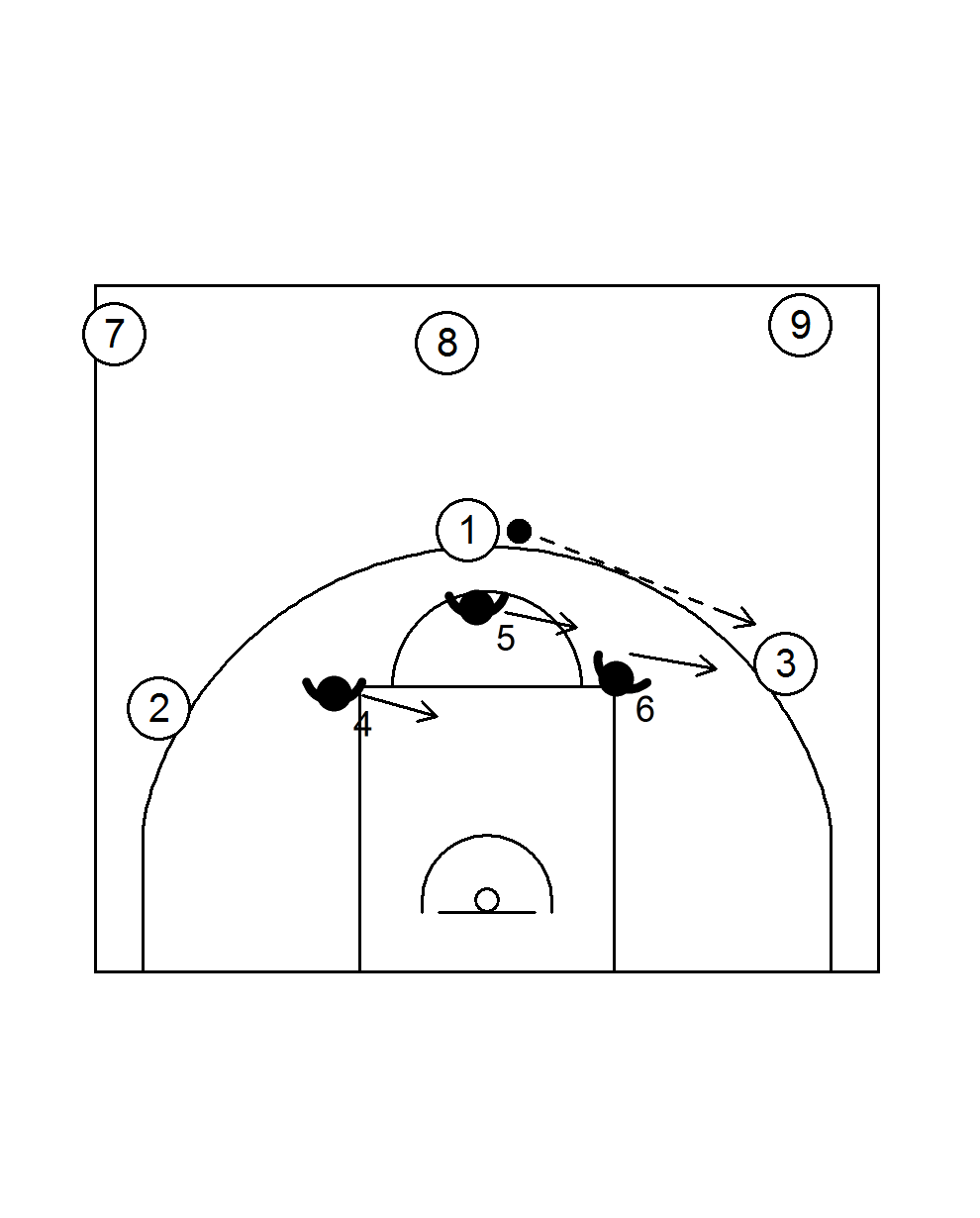
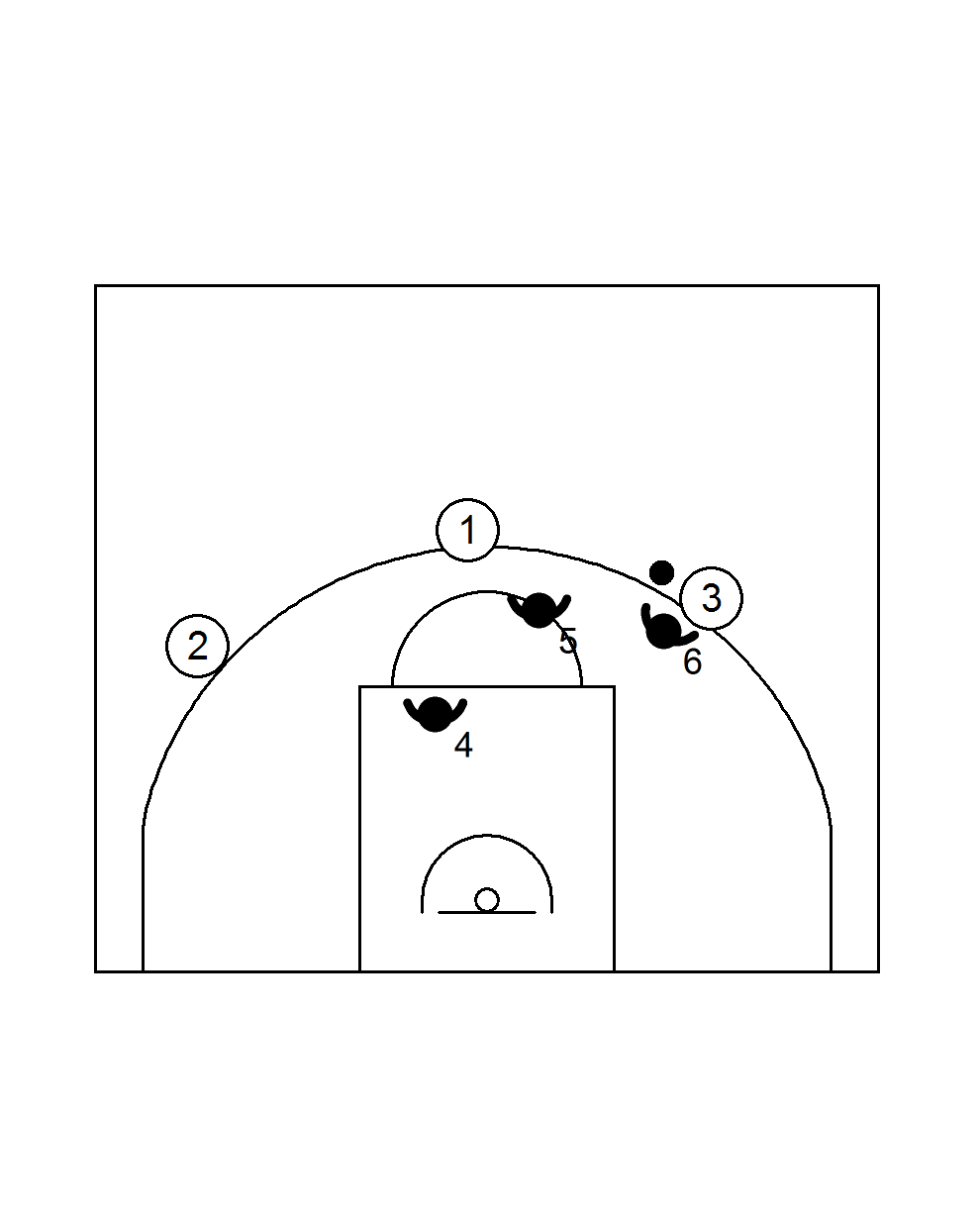
Requirements:
players must be able to play individually 1 against 1
Goal: train position of the defender to help prevent penetration (instead of passing over) + recovery
Preparation:
- the defender must first choose his position in such a way that he can help stop the penetration
- after matching the attacker, he takes up his position between the ball and the ring
- at the distance suited to the qualities of the attacker
- or at the distance requested by the coach
- the players play 1 against 1
- Attacker becomes defender.
- New attacker turns in
Organisation:
- the three defenders start in the bucket, with the ball
- defender 5 rolls the ball to 1 and defenders take up their positions
- attackers hold their position and pass the ball back and forth (also pass fakes!!)
- they may score with a drive or a dribble with jump shot
- a three-point is a point for the attack
- a two-point shot is a point for the offense, but
- if there is still a defender between the shooter and the basket at the moment of shooting, it is a point for the defense
- interception or defensive rebound is a point for the defense
- play until the 5, then change
Teaching Points:
- defenders have to take the right position immediately after the pass with an explosive step
- Anticipate the pass and take a slide step so that you can get to your defensive position earlier (in case of a pass fake, you have to take a slide step back quickly)
- one pass away = one metre from your man and one metre from the passing line, so that you can help with the penetration of the ball
- when the ball is 2 passes away, you have to stand with 2 feet in the bucket
- immediately after the shot, both defenders must look at their man instead of the ball and box out
Variations:
- offensive rebound is a point for the attack (if you want to emphasize boxing out)
- shallow cut from 1 after the pass + 2 rotates to the head
- shallow cut from 1 after the pass + 2 sets a screen for 1 under the elbow and then steps out to the guard position
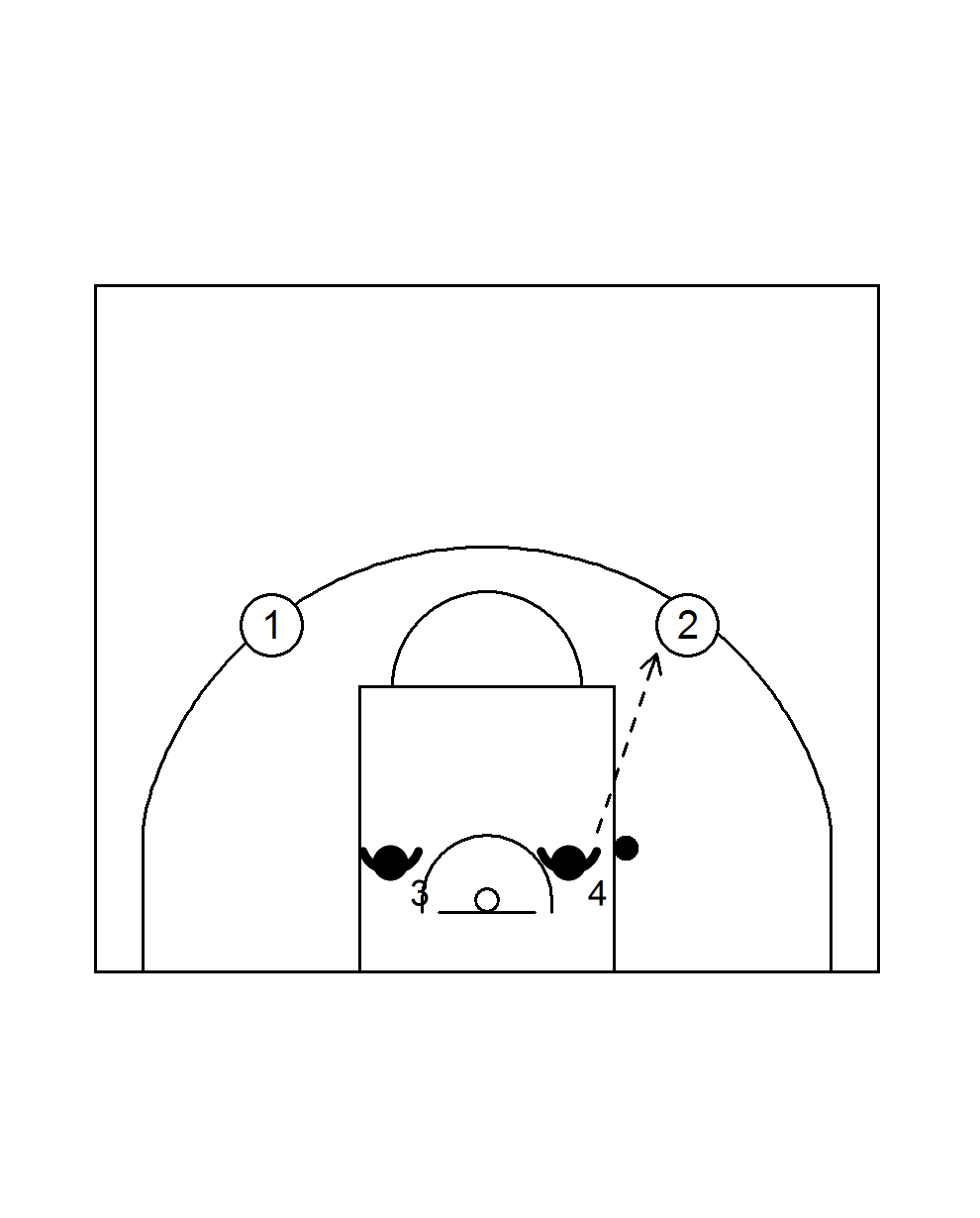
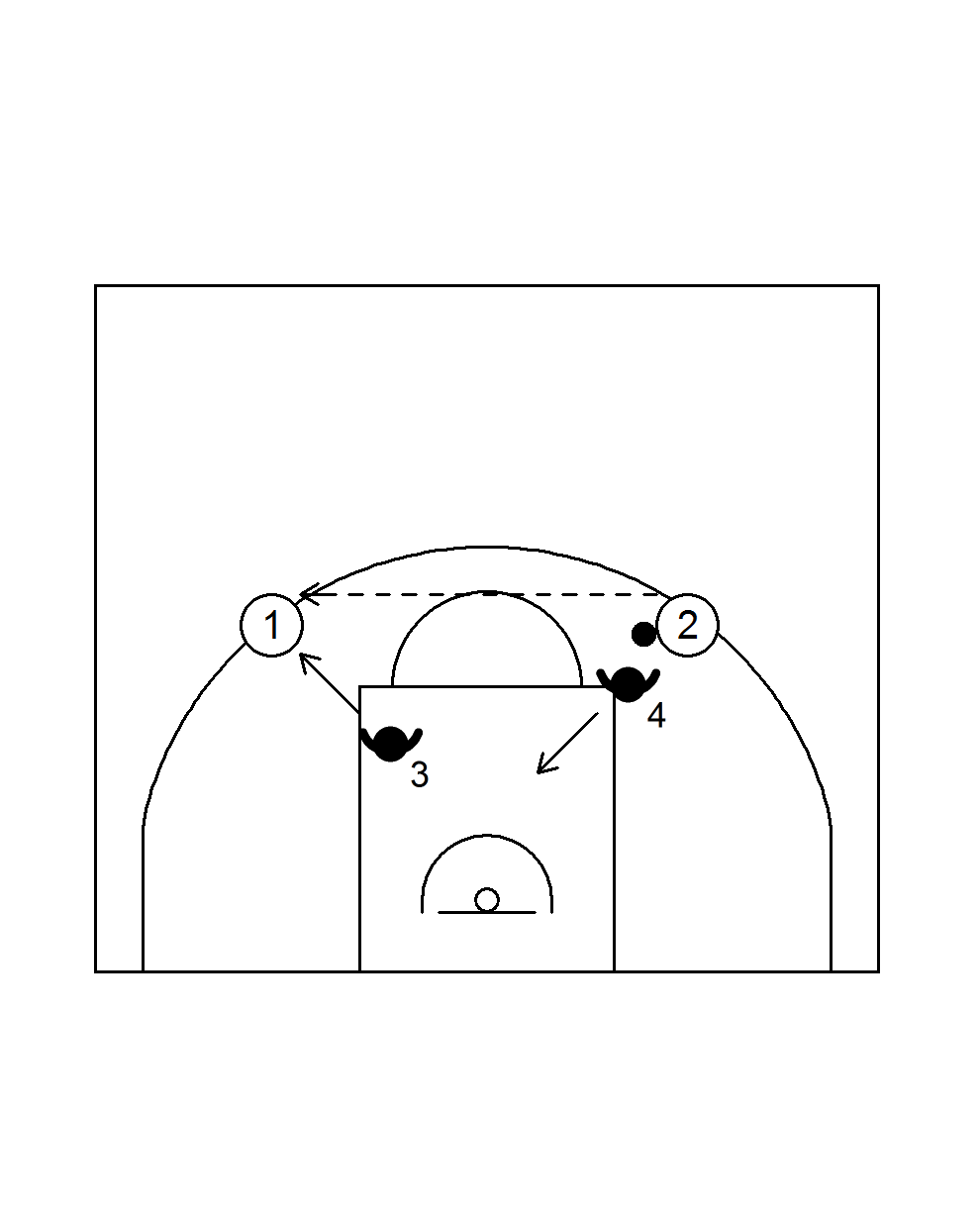
Requirements:
players must be able to play individually 1 against 1
Goal1: Improve the position change of the defender between helpside and ballside defense
Goal2: boxing out after the shot
Organisation:
- one of the defenders passes the ball from under the basket to an attacker
- A defender on the ball side closes the way to the basket (close out).
- the other defender takes the help side position: one foot in the bucket if the ball is above the free throw line; on the basket-basket line if the ball is below the free throw line
- When the ball is passed to the weak side, both defenders must quickly adjust their position relative to their man.
Substitutions:
- make it, take it
- or two is too much (push up defenders after 2 consecutive scores)
- (if you have more than 4 players, let the other players practice shooting at the other basket)
Teaching Points:
- Close out weak side shooter
- two explosive sprint steps, then lower your hips a bit + reduce step size
- inside foot in front
- outside hand in the shooter's face
- After the shot:
- immediately after the shot, both defenders must look at their man instead of the ball and box out
- put the forearm on the chest of the attacker
- box out with a front pivot or a reverse pivot and chase the ball
Variations:
- defenders may score from a rebound or interception
- the scoring team continues to attack
- play until the 7
Prerequisites:
players must be quite proficient and in good shape
Objective:
concentration and energy in defense
Organization:
- 4 against 4 on one basket
- new defenders when the defence has made 3 stops (i.e. the defenders gain possession of the ball).
- after a score or a foul on the shot, the defending team returns one stop
- The exercise lasts 12 minutes
- and if you do not defend well, you are defending for 12 minutes.
- if the attacks take too long, the trainer will count down loudly: 5-4-3-2-1-0
Teaching Points:
- After 2 stops the whole defense steps up their game. When they make the third stop, they can start attacking.
- As a side effect, the attackers learn in a playful way who will hit the balls when it gets exciting, and who will not.
When you have 12 men:
- rotate with 4 men
- After every stop, score or foul on the shot, a new team of attackers enters the field (trainer determines if it is a foul).
- the team that causes the third and last stop goes to defend
Variations:
- three defenders, four attackers
- make 2 or 3 consecutive stops before being allowed to change.
- (with shot clock) 35 seconds of defense without scoring and without a foul. At a stop, the clock stays on and the attackers can try again. If the attackers score, or grab an offensive rebound, or if the defense makes a foul, the clock goes back to 35 seconds.
Prerequisites:
players must know how to apply help side and ball side defense
Goal: to learn each defense system
Organization:
- a team can get a point with a defensive stop, with a score from a fast break or with a three-pointer from the secundary break
- (stopping the break by capturing the ball counts as a defensive stop)
- winner is the team that earns the last point OR, if no one earns a point, the team that scores
- the winner may always go and defend
- new attackers enter the field
Teaching Points:
all aspects of team defense
Tips:
- defending the break is also part of this exercise. That is why the three-pointer from the secondary break is also a point. This forces all players to defend after losing the ball in the attack.
- If the break is not executed quickly, blow it off. This will improve the speed at which the players react.
Note: The illustration shows the situation after a score from a break. The defenders first made a stop and then scored from the (secundary) break. So, two points. They therefore continue to defend and new attackers have entered the field
Prerequisites:
players must know what a double team is
Goal:
- to train double teaming
- dynamic organizing and reorganizing of the defense
- practice transition
Organization:
- 3 players attack along the length of the whole field
- 3 attackers start at the half way line
- 3 defenders per half
- of both defending teams one player takes up position near the half way line
- defender 6 waits near the halfway line
- can only start defending when the ball is in the attacking half
- must sprint with both feet through the centre circle before joining the defence
- from that moment on, two defenders must always try to double team the man with the ball
Rotation after scoring:
- the defender closest to the half way line immediately takes up his position next to the pitch
- attackers must take the ball from the back line
- the three remaining defenders try to prevent this (5 seconds)
- if that does not work, they have to try to trap the dribbler with a double team
- if the defenders capture the ball, they immediately attack the same basket again (like in a Full Court Press in a game)
- the fourth defender joins the defense (i.e. the other three) immediately after the turnover
Rotation after the turnover:
- the player with the ball in his hands hands hands it off to another player and takes up his position near the center line.
- the three remaining players attack the other basket
- the team that has lost the ball defends.
Teaching Points:
defenders always try to conquer the ball with a double team.
Variation:
can also be played 3 against 3 + 1 half court: after a score the attackers have to take the ball and get it over the half court 1
Prerequisites:
players must know what help side defense and what ball side defense is
Goal: train early help and quick recovery
Organisation:
- the three defenders stand facing the back line and take up their defensive positions as soon as the coach passes
- coach passes the ball to a random attacker
- the attackers have 10 seconds to score and the coach counts down aloud
- play until the 3 stops or a difference of 2 (stops scores), then change
- screens on the ball are not allowed
Teaching Points:
- defenders must move when the ball is in the air
- occupy the agreed-upon helper position
- stop the penetration when the man with the ball passes his defender
- anticipate the swing pass: take the first step towards your own man even before or as soon as the passer picks up the ball
- Communication as agreed within the team
Variations:
attackers are only allowed to score from the bucket.
Variation with more competition element:
- attacker with ball starts at 2 meter of the three-point-line; place to be determined by the team.
- must start with a dribble
- the defenders may turn around at the first dribble
- the attackers must make a goal attempt within 20 seconds - the waiting players count down
- you can only earn points in defense
- two stops in a row are one point
- if you score twice in a row, you may go on defense
- Losers turn out
- new attackers turn in
- play until the 3
Requirements:
- players must individually be able to defend the man with the ball
- players must know how to defend the man without the ball
Goal: To apply individual defensive technique in a simplified game situation
Organization:
- attackers use a quarter of the playing field
- are not allowed to cross the lifeline
- play 2 against 2
- winners will attack on the other half of the field
- losers keep on defending on this quarter (when there are more than 8 players, turn in at the halfway line)
Teaching Points:
- emphasise what you have taught the players individually
- there is no help (this makes it clear who is not defending well).
Variations:
- let the defender keep their hands behind their back if you want to emphasise footwork In the picture:
- Defenders 1 and 2 have conquered the ball without allowing attackers 1 and 2 to score
- defenders 1 and 2 attack on the other half of the pitch
- 5 and 6 will enter as defenders and play against the winners of 3 and 4
- former attackers 1 and 2 wait for their turn to defend
Prerequisites:
players must know what help side defense and what ball side defense is
Goal: train early help and quick recovery
Organization:
- attacker 5 threatens with a drive outside, changes hands and attacks the elbow
- defender 1 starts with a foot in the bucket and needs to help early
- on the pass to the corner, defender 1 must recover his position with a sprint and close out
- defender 2 must drop far enough to stop a drive from 4
- the attackers must make a goal attempt within 20 sec - the waiting players count down
- you can only earn points in defence
- two stops in a row are one point
- if you score twice in a row, you may go on defense
- Losers turn out
- new attackers turn in
- play until the 3
Teaching Points:
- defenders must move when the ball is in the air
- the helper position is such that you can stop the penetration when the man with the ball passes his defender
- Anticipate the pass: take the first step towards your own man as soon as the dribbler picks up the ball
- Communication as agreed within the team
- close out = 2 sprint steps followed by minislides + lower hips + 1 hand up
- the helper position is below the line ball - you - man + chest parallel
Prerequisites:
players must be quite proficient and in good physical condition
Organization:
after one team has scored 2 times the defenders go out of the field the winners get the ball
Ends when one team has won 5 times.
Losers have to work very hard physically afterwards. They should know this in advance so they will do their utmost to not lose.
If the MTM is not intense enough then the coach will award a score to the offensive side
Losers: (= minute drill: 45 sec full, 15 sec rest)
For each point difference in the score:
- 4 sprints back and forth across the field
- Push-ups until signal of the trainer
- 15 sec rest (players who lost by 1 point difference are finished)
- 4 sprints + sit ups until signal of the trainer
- 15 sec rest (players who lost by 2 points are finished)
- etc
If you are with 8 players:
- the two players who turn in ask one of the players who got out to join them
- players then count individually the number of times won








